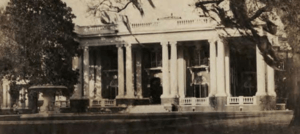Greenwich Plantation facts for kids
Quick facts for kids Greenwich Plantation |
|
|---|---|

The Greenwich Plantation mansion, pictured circa 1910, about halfway through its existence. The fountain still stands today
|
|
| Alternative names | Greenwich Place |
| General information | |
| Location | Colonial Savannah, Province of Georgia |
| Address | Greenwich Road |
| Coordinates | 32°03′05″N 81°02′23″W / 32.0513°N 81.0396°W |
| Completed | 1900 (mansion only) |
| Destroyed | 1923 (mansion only) |
| Owner |
|
| Technical details | |
| Floor count | 3 |
| Other information | |
| Number of rooms | 40 |
Greenwich Plantation (also known as Greenwich Place) was a plantation founded in colonial Savannah, Province of Georgia, in 1765, on land now occupied by Greenwich Cemetery. The site was 100 acres (0.40 km2), including a plantation house (completed in 1900) and private cemetery, located on the Wilmington River, about 3.5 miles (6 kilometres) east of the Savannah colony. It was located immediately to the north of (and on the same bluff as) Bonaventure Plantation, which existed until 1868 on land now occupied by Bonaventure Cemetery. Its mile-long driveway still exists to the left of Bonaventure's main gates.
History
The plantation was established in April 1765 by Samuel Bowen, who bought 450 acres (1.8 km2) of land in Thunderbolt, which he named Greenwich. On his new estate, Bowen began to grow soya beans, then known as "Luk Taw" or "Chinese vetch", from which he made soy sauce and vermicelli noodles. He suspected that the sprouts of his plants had antiscorbutic properties that would be of use to the British Royal Navy in their fight against scurvy, research that led to his receiving a gold medal from the Society for the Encouragement of Arts, Manufactures and Commerce in 1766 and a gift of £200 from King George III. The following year, Bowen received a patent from the British government for his "new invented method of preparing and making sago, vermicelli and soy from plants growing in America, to be equal in goodness to those made in the East Indies". According to the 1805 The American Universal Geography, Bowen also introduced tea from China to Georgia. These activities likely brought Bowen to the attention of the American Philosophical Society in Philadelphia, which elected him to membership in 1769.
Upon his death in 1777, ownership transferred to Bowen's wife, Jeanie (Jane) Spencer, daughter of Savannah customs collector William Spencer. She hosted two officers from the fleet of Charles Hector, comte d'Estaing, at Greenwich during the Second Battle of Savannah. She supervised the burial of Polish General Casimir Pulaski, who was killed during the battle, "between her mansion and the river".
Jeanie Bowen sold the plantation in 1797 to Samuel Beechcroft.
The next known owner was Captain F.C. Threadcraft, who lived on the plantation until 1874, at which point it was taken over by Savannah Schutzen Gesellschaft, a German rifle club.
Greenwich Park Association became the new owners in 1887, and its director, Canadian-born Spencer Proudfoot Shotter (1855 – December 5, 1920), a naval stores magnate, bought it outright in 1896. (Shotter also owned Shadowbrook in the Berkshires of Massachusetts between 1905 and 1912, but was still a resident of Savannah.) In 1898, Shotter began building a Beaux-Arts mansion which had double colonnades, 28 columns on three sides, each measuring 28 inches in diameter and more than twenty feet tall. It had extensive gardens containing expanses of lawn, boxwood hedges, imported plants and decorative pools. He renamed the location Greenwich Place. Shotter lost his fortunes (and was jailed for three months) after becoming embroiled in an anti-trust lawsuit and sold the property to Doctor Henry Norton Torrey, a brain surgeon from Detroit. Torrey was the owner between 1917 and 1923 and wintered there with his wife, Nell, and two children, William (1911–1958) and Eleanor (1913–2021), as well as eighteen members of service staff.
At the time of the Torreys' purchase of Greenwich Place, it had "an elaborately furnished main house, a six-car garage, a laundry building, a superintendent's office and cottage, a gate lodge, a chauffeur's cottage, other servants' quarters, an artificial pond, and formal gardens." It also contained "a ballroom, library, billiards room, reception room, drawing room, music room, butler's pantry, refrigeration pantry, twelve master bedrooms and ten baths." Outside there were stables (which are still visible), a dairy farm, a 200-foot-long greenhouse (at the western edge of the mansion), a bath and pool house, and a yacht dock. It was said to have rivaled the Vanderbilts' Biltmore Estate in Asheville, North Carolina, as the most opulent in the South.
The house and grounds were used in several silent films, including Mice and Men (1916) and Stolen Moments (1920).
On January 27, 1923, the three-storey, 40-room brick and marble plantation mansion burned to the ground. A ten-year-old Eleanor jumped from the second floor to escape, and Dr. Torrey had to rescue his grandmother, Mrs. M.T. Garrison. Instead of rebuilding, the family moved to Ossabaw Island, where they built a house between 1924 and 1926, taking with them the two large iron gates from Greenwich Place.
In 1933, the City of Savannah purchased the land that the plantation once occupied for $75,000 and named it the "Greenwich Addition to Bonaventure". With it came fourteen of Shotter's statues, which he bought during a trip to Rome in 1912 and which arrived by boat in Savannah that July. The city placed them in storage, where they remained until 1965, at which point they were loaned to Savannah's Telfair Museums.
In 2020, the City approved the sale of the statues, with a collective price tag of $400,000. One item was kept because it was part of a set of two, the other part being on display at Telfair.
The original fountain at Greenwich still exists, marking the former location of the mansion, as does the butterfly lake, which was traversed by an arched bridge.

